Eating Disorder: Causes, Symptoms, Diagnosis and Management
VerifiedAdded on 2023/05/30
|12
|3635
|308
AI Summary
This essay discusses the causes, symptoms, diagnosis, and management of eating disorders, including anorexia, bulimia, and binge eating disorder. Family-based treatments, including structural, strategic, and narrative therapies, are discussed. The essay emphasizes the importance of family involvement in the treatment of eating disorders.
Contribute Materials
Your contribution can guide someone’s learning journey. Share your
documents today.
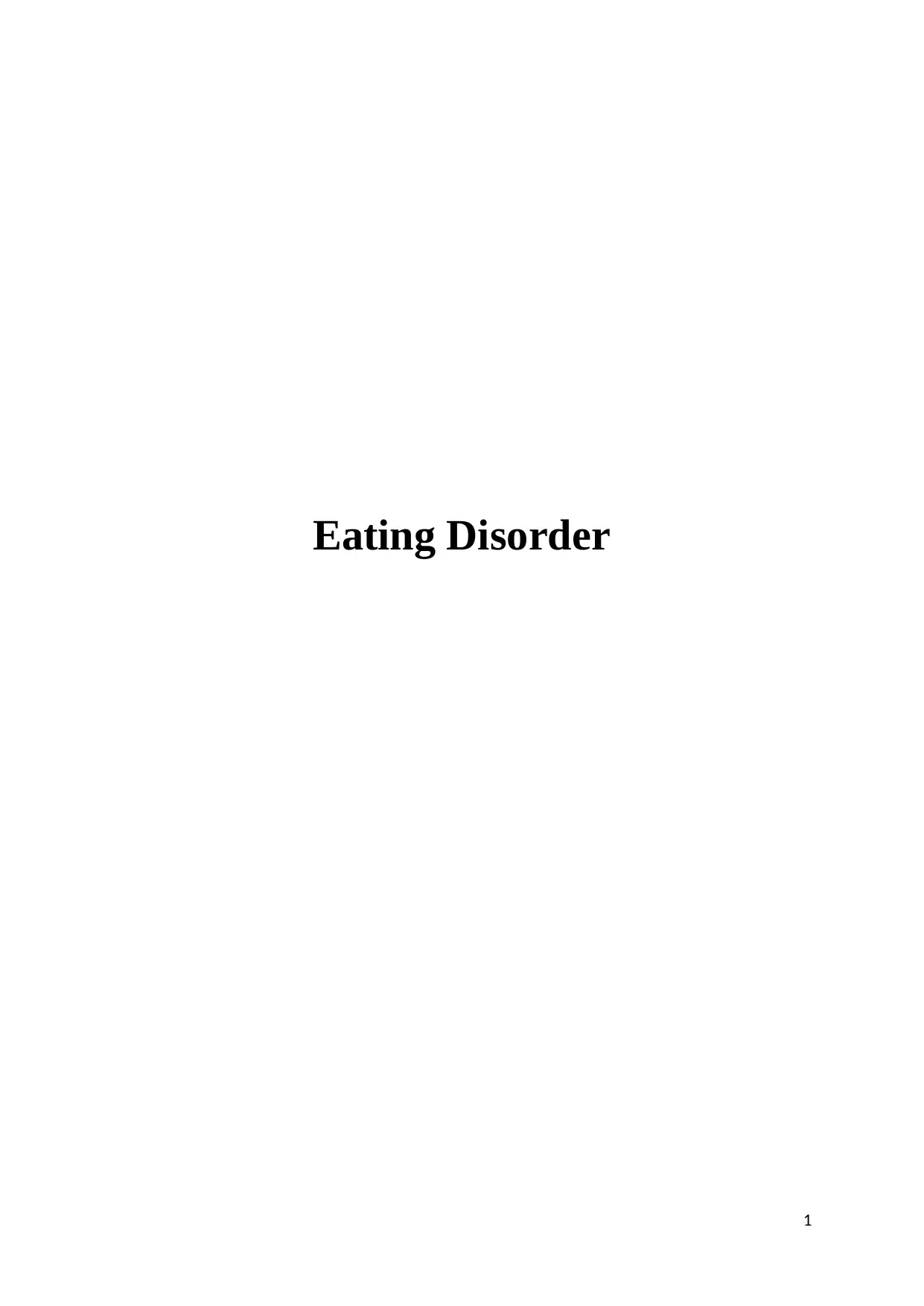
Eating Disorder
1
1
Secure Best Marks with AI Grader
Need help grading? Try our AI Grader for instant feedback on your assignments.
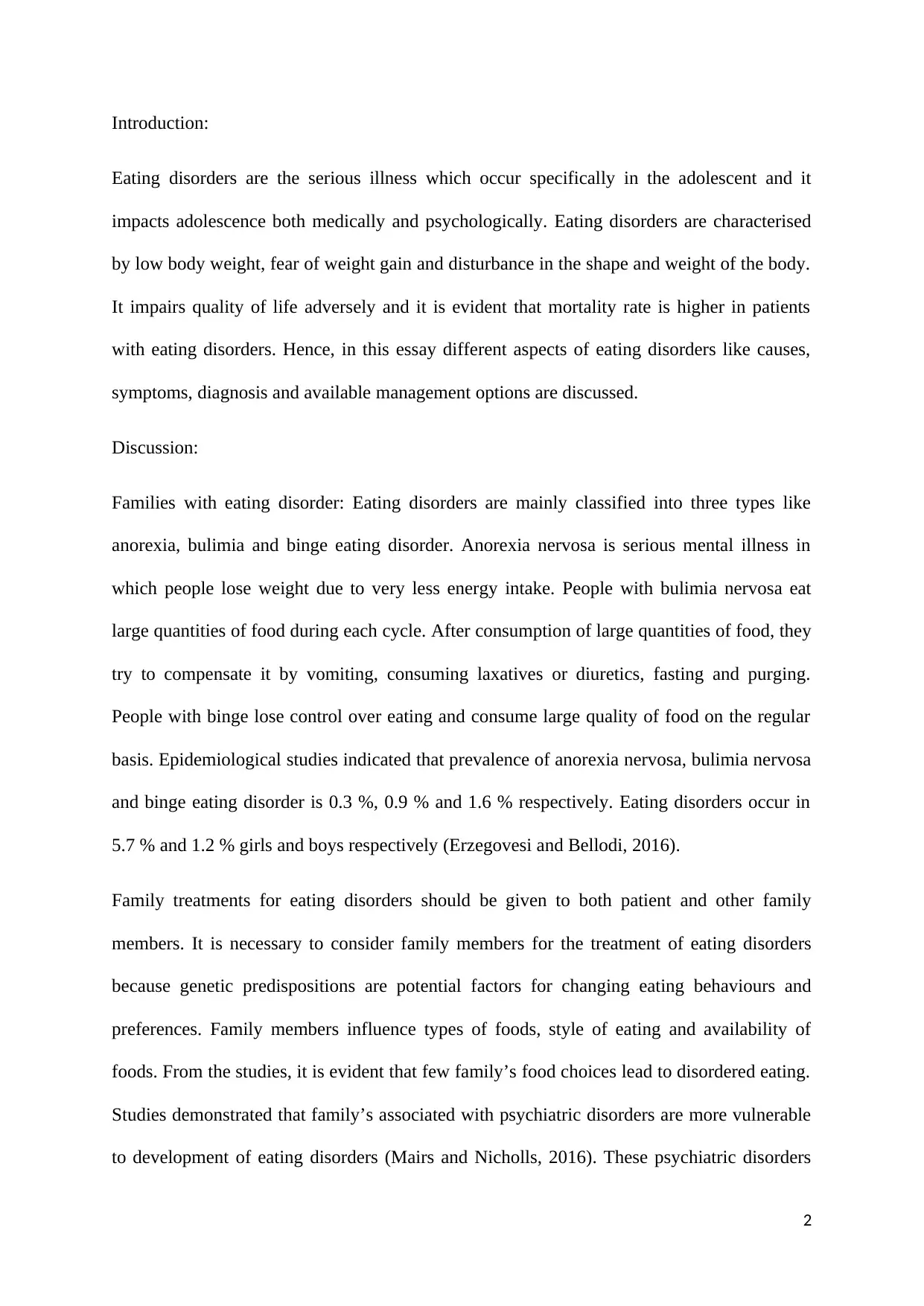
Introduction:
Eating disorders are the serious illness which occur specifically in the adolescent and it
impacts adolescence both medically and psychologically. Eating disorders are characterised
by low body weight, fear of weight gain and disturbance in the shape and weight of the body.
It impairs quality of life adversely and it is evident that mortality rate is higher in patients
with eating disorders. Hence, in this essay different aspects of eating disorders like causes,
symptoms, diagnosis and available management options are discussed.
Discussion:
Families with eating disorder: Eating disorders are mainly classified into three types like
anorexia, bulimia and binge eating disorder. Anorexia nervosa is serious mental illness in
which people lose weight due to very less energy intake. People with bulimia nervosa eat
large quantities of food during each cycle. After consumption of large quantities of food, they
try to compensate it by vomiting, consuming laxatives or diuretics, fasting and purging.
People with binge lose control over eating and consume large quality of food on the regular
basis. Epidemiological studies indicated that prevalence of anorexia nervosa, bulimia nervosa
and binge eating disorder is 0.3 %, 0.9 % and 1.6 % respectively. Eating disorders occur in
5.7 % and 1.2 % girls and boys respectively (Erzegovesi and Bellodi, 2016).
Family treatments for eating disorders should be given to both patient and other family
members. It is necessary to consider family members for the treatment of eating disorders
because genetic predispositions are potential factors for changing eating behaviours and
preferences. Family members influence types of foods, style of eating and availability of
foods. From the studies, it is evident that few family’s food choices lead to disordered eating.
Studies demonstrated that family’s associated with psychiatric disorders are more vulnerable
to development of eating disorders (Mairs and Nicholls, 2016). These psychiatric disorders
2
Eating disorders are the serious illness which occur specifically in the adolescent and it
impacts adolescence both medically and psychologically. Eating disorders are characterised
by low body weight, fear of weight gain and disturbance in the shape and weight of the body.
It impairs quality of life adversely and it is evident that mortality rate is higher in patients
with eating disorders. Hence, in this essay different aspects of eating disorders like causes,
symptoms, diagnosis and available management options are discussed.
Discussion:
Families with eating disorder: Eating disorders are mainly classified into three types like
anorexia, bulimia and binge eating disorder. Anorexia nervosa is serious mental illness in
which people lose weight due to very less energy intake. People with bulimia nervosa eat
large quantities of food during each cycle. After consumption of large quantities of food, they
try to compensate it by vomiting, consuming laxatives or diuretics, fasting and purging.
People with binge lose control over eating and consume large quality of food on the regular
basis. Epidemiological studies indicated that prevalence of anorexia nervosa, bulimia nervosa
and binge eating disorder is 0.3 %, 0.9 % and 1.6 % respectively. Eating disorders occur in
5.7 % and 1.2 % girls and boys respectively (Erzegovesi and Bellodi, 2016).
Family treatments for eating disorders should be given to both patient and other family
members. It is necessary to consider family members for the treatment of eating disorders
because genetic predispositions are potential factors for changing eating behaviours and
preferences. Family members influence types of foods, style of eating and availability of
foods. From the studies, it is evident that few family’s food choices lead to disordered eating.
Studies demonstrated that family’s associated with psychiatric disorders are more vulnerable
to development of eating disorders (Mairs and Nicholls, 2016). These psychiatric disorders
2
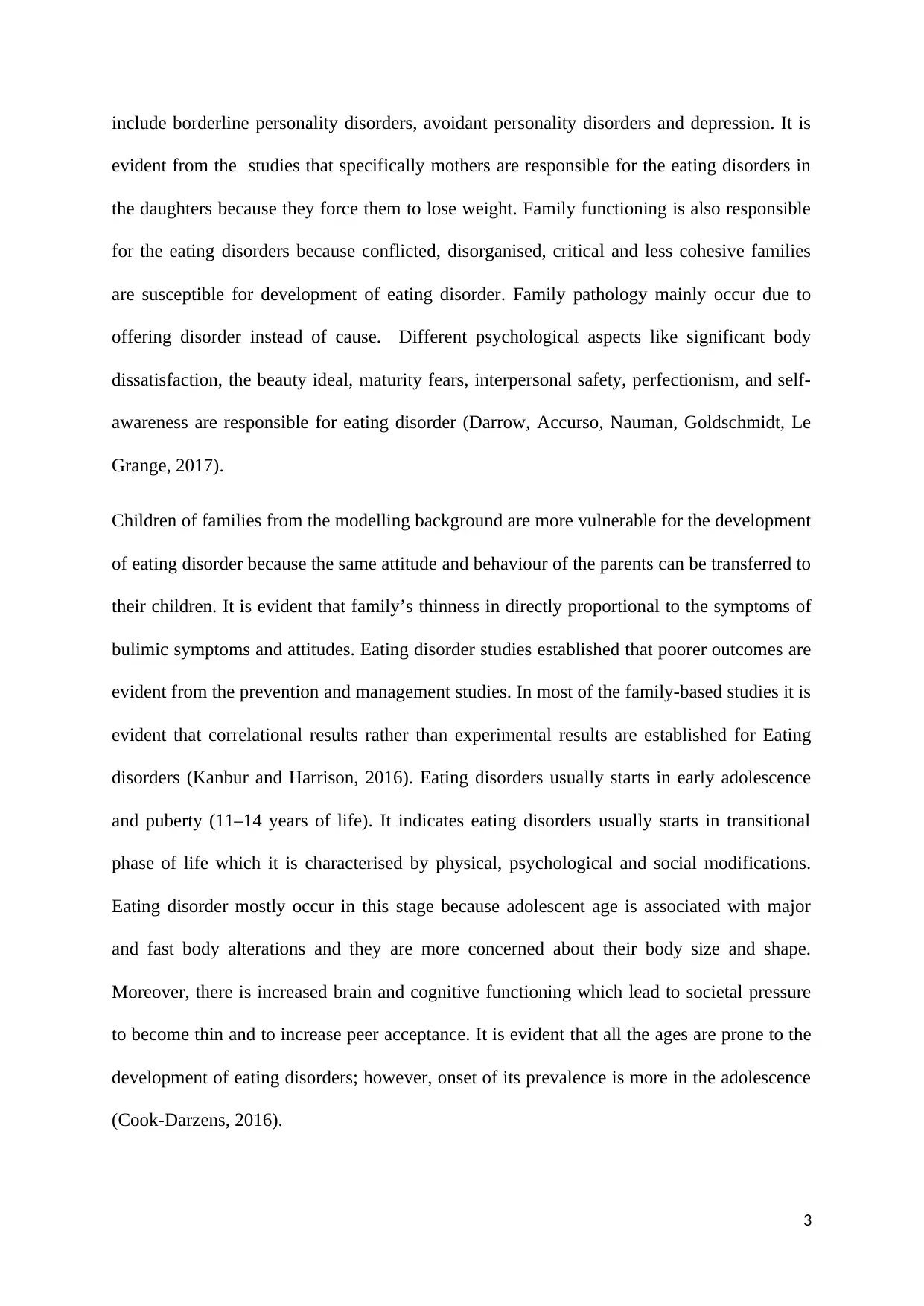
include borderline personality disorders, avoidant personality disorders and depression. It is
evident from the studies that specifically mothers are responsible for the eating disorders in
the daughters because they force them to lose weight. Family functioning is also responsible
for the eating disorders because conflicted, disorganised, critical and less cohesive families
are susceptible for development of eating disorder. Family pathology mainly occur due to
offering disorder instead of cause. Different psychological aspects like significant body
dissatisfaction, the beauty ideal, maturity fears, interpersonal safety, perfectionism, and self-
awareness are responsible for eating disorder (Darrow, Accurso, Nauman, Goldschmidt, Le
Grange, 2017).
Children of families from the modelling background are more vulnerable for the development
of eating disorder because the same attitude and behaviour of the parents can be transferred to
their children. It is evident that family’s thinness in directly proportional to the symptoms of
bulimic symptoms and attitudes. Eating disorder studies established that poorer outcomes are
evident from the prevention and management studies. In most of the family-based studies it is
evident that correlational results rather than experimental results are established for Eating
disorders (Kanbur and Harrison, 2016). Eating disorders usually starts in early adolescence
and puberty (11–14 years of life). It indicates eating disorders usually starts in transitional
phase of life which it is characterised by physical, psychological and social modifications.
Eating disorder mostly occur in this stage because adolescent age is associated with major
and fast body alterations and they are more concerned about their body size and shape.
Moreover, there is increased brain and cognitive functioning which lead to societal pressure
to become thin and to increase peer acceptance. It is evident that all the ages are prone to the
development of eating disorders; however, onset of its prevalence is more in the adolescence
(Cook-Darzens, 2016).
3
evident from the studies that specifically mothers are responsible for the eating disorders in
the daughters because they force them to lose weight. Family functioning is also responsible
for the eating disorders because conflicted, disorganised, critical and less cohesive families
are susceptible for development of eating disorder. Family pathology mainly occur due to
offering disorder instead of cause. Different psychological aspects like significant body
dissatisfaction, the beauty ideal, maturity fears, interpersonal safety, perfectionism, and self-
awareness are responsible for eating disorder (Darrow, Accurso, Nauman, Goldschmidt, Le
Grange, 2017).
Children of families from the modelling background are more vulnerable for the development
of eating disorder because the same attitude and behaviour of the parents can be transferred to
their children. It is evident that family’s thinness in directly proportional to the symptoms of
bulimic symptoms and attitudes. Eating disorder studies established that poorer outcomes are
evident from the prevention and management studies. In most of the family-based studies it is
evident that correlational results rather than experimental results are established for Eating
disorders (Kanbur and Harrison, 2016). Eating disorders usually starts in early adolescence
and puberty (11–14 years of life). It indicates eating disorders usually starts in transitional
phase of life which it is characterised by physical, psychological and social modifications.
Eating disorder mostly occur in this stage because adolescent age is associated with major
and fast body alterations and they are more concerned about their body size and shape.
Moreover, there is increased brain and cognitive functioning which lead to societal pressure
to become thin and to increase peer acceptance. It is evident that all the ages are prone to the
development of eating disorders; however, onset of its prevalence is more in the adolescence
(Cook-Darzens, 2016).
3
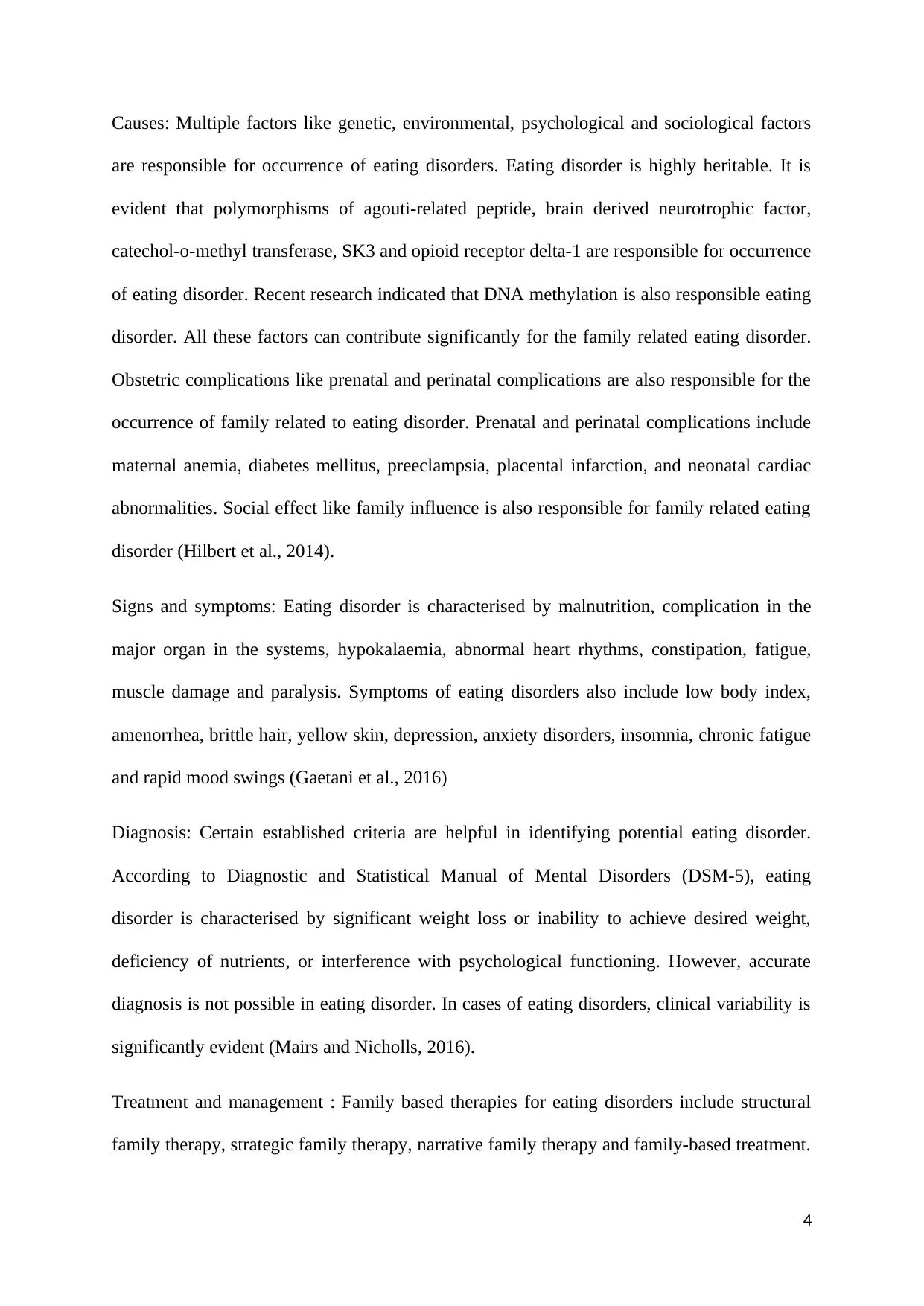
Causes: Multiple factors like genetic, environmental, psychological and sociological factors
are responsible for occurrence of eating disorders. Eating disorder is highly heritable. It is
evident that polymorphisms of agouti-related peptide, brain derived neurotrophic factor,
catechol-o-methyl transferase, SK3 and opioid receptor delta-1 are responsible for occurrence
of eating disorder. Recent research indicated that DNA methylation is also responsible eating
disorder. All these factors can contribute significantly for the family related eating disorder.
Obstetric complications like prenatal and perinatal complications are also responsible for the
occurrence of family related to eating disorder. Prenatal and perinatal complications include
maternal anemia, diabetes mellitus, preeclampsia, placental infarction, and neonatal cardiac
abnormalities. Social effect like family influence is also responsible for family related eating
disorder (Hilbert et al., 2014).
Signs and symptoms: Eating disorder is characterised by malnutrition, complication in the
major organ in the systems, hypokalaemia, abnormal heart rhythms, constipation, fatigue,
muscle damage and paralysis. Symptoms of eating disorders also include low body index,
amenorrhea, brittle hair, yellow skin, depression, anxiety disorders, insomnia, chronic fatigue
and rapid mood swings (Gaetani et al., 2016)
Diagnosis: Certain established criteria are helpful in identifying potential eating disorder.
According to Diagnostic and Statistical Manual of Mental Disorders (DSM-5), eating
disorder is characterised by significant weight loss or inability to achieve desired weight,
deficiency of nutrients, or interference with psychological functioning. However, accurate
diagnosis is not possible in eating disorder. In cases of eating disorders, clinical variability is
significantly evident (Mairs and Nicholls, 2016).
Treatment and management : Family based therapies for eating disorders include structural
family therapy, strategic family therapy, narrative family therapy and family-based treatment.
4
are responsible for occurrence of eating disorders. Eating disorder is highly heritable. It is
evident that polymorphisms of agouti-related peptide, brain derived neurotrophic factor,
catechol-o-methyl transferase, SK3 and opioid receptor delta-1 are responsible for occurrence
of eating disorder. Recent research indicated that DNA methylation is also responsible eating
disorder. All these factors can contribute significantly for the family related eating disorder.
Obstetric complications like prenatal and perinatal complications are also responsible for the
occurrence of family related to eating disorder. Prenatal and perinatal complications include
maternal anemia, diabetes mellitus, preeclampsia, placental infarction, and neonatal cardiac
abnormalities. Social effect like family influence is also responsible for family related eating
disorder (Hilbert et al., 2014).
Signs and symptoms: Eating disorder is characterised by malnutrition, complication in the
major organ in the systems, hypokalaemia, abnormal heart rhythms, constipation, fatigue,
muscle damage and paralysis. Symptoms of eating disorders also include low body index,
amenorrhea, brittle hair, yellow skin, depression, anxiety disorders, insomnia, chronic fatigue
and rapid mood swings (Gaetani et al., 2016)
Diagnosis: Certain established criteria are helpful in identifying potential eating disorder.
According to Diagnostic and Statistical Manual of Mental Disorders (DSM-5), eating
disorder is characterised by significant weight loss or inability to achieve desired weight,
deficiency of nutrients, or interference with psychological functioning. However, accurate
diagnosis is not possible in eating disorder. In cases of eating disorders, clinical variability is
significantly evident (Mairs and Nicholls, 2016).
Treatment and management : Family based therapies for eating disorders include structural
family therapy, strategic family therapy, narrative family therapy and family-based treatment.
4
Secure Best Marks with AI Grader
Need help grading? Try our AI Grader for instant feedback on your assignments.
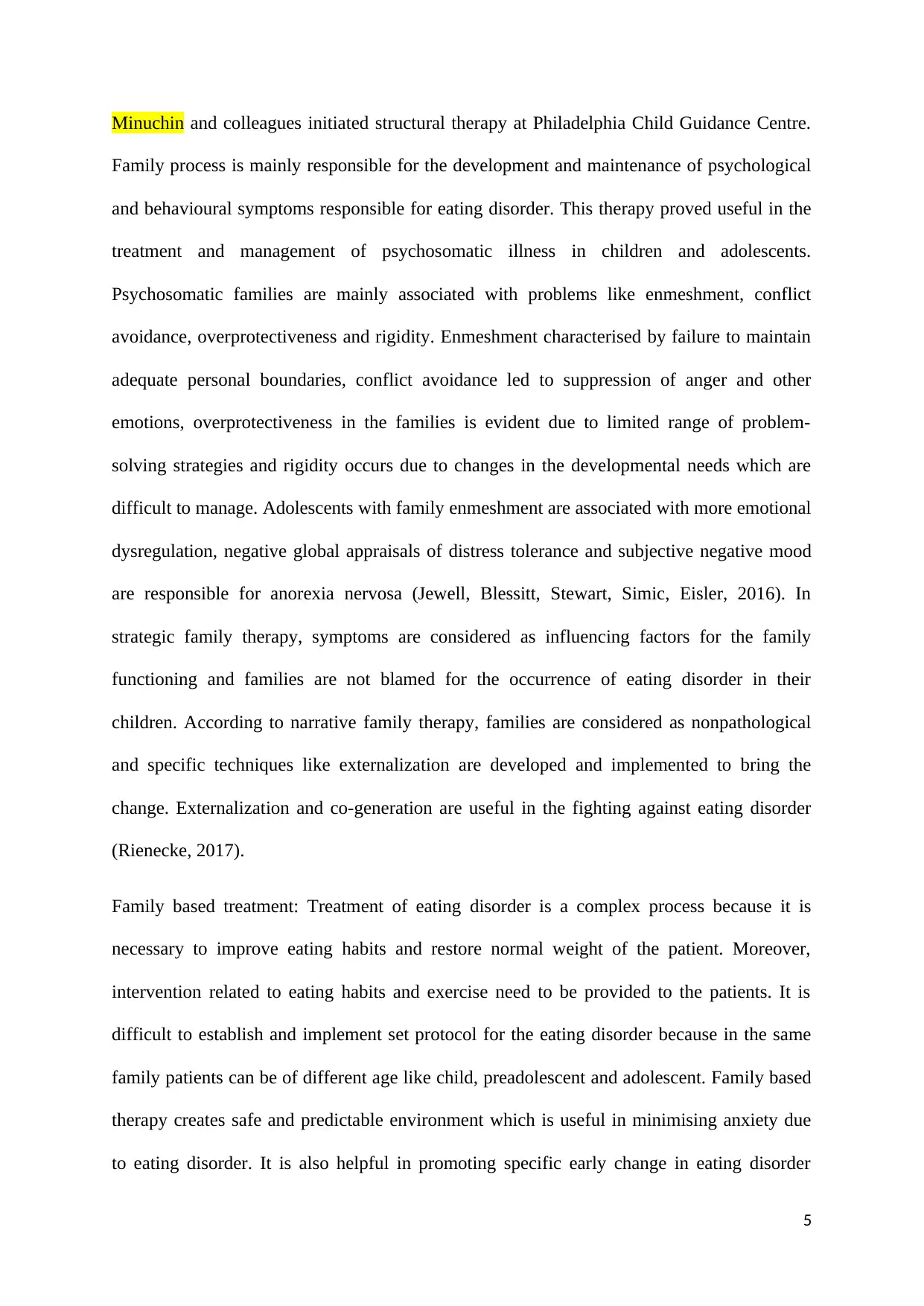
Minuchin and colleagues initiated structural therapy at Philadelphia Child Guidance Centre.
Family process is mainly responsible for the development and maintenance of psychological
and behavioural symptoms responsible for eating disorder. This therapy proved useful in the
treatment and management of psychosomatic illness in children and adolescents.
Psychosomatic families are mainly associated with problems like enmeshment, conflict
avoidance, overprotectiveness and rigidity. Enmeshment characterised by failure to maintain
adequate personal boundaries, conflict avoidance led to suppression of anger and other
emotions, overprotectiveness in the families is evident due to limited range of problem-
solving strategies and rigidity occurs due to changes in the developmental needs which are
difficult to manage. Adolescents with family enmeshment are associated with more emotional
dysregulation, negative global appraisals of distress tolerance and subjective negative mood
are responsible for anorexia nervosa (Jewell, Blessitt, Stewart, Simic, Eisler, 2016). In
strategic family therapy, symptoms are considered as influencing factors for the family
functioning and families are not blamed for the occurrence of eating disorder in their
children. According to narrative family therapy, families are considered as nonpathological
and specific techniques like externalization are developed and implemented to bring the
change. Externalization and co-generation are useful in the fighting against eating disorder
(Rienecke, 2017).
Family based treatment: Treatment of eating disorder is a complex process because it is
necessary to improve eating habits and restore normal weight of the patient. Moreover,
intervention related to eating habits and exercise need to be provided to the patients. It is
difficult to establish and implement set protocol for the eating disorder because in the same
family patients can be of different age like child, preadolescent and adolescent. Family based
therapy creates safe and predictable environment which is useful in minimising anxiety due
to eating disorder. It is also helpful in promoting specific early change in eating disorder
5
Family process is mainly responsible for the development and maintenance of psychological
and behavioural symptoms responsible for eating disorder. This therapy proved useful in the
treatment and management of psychosomatic illness in children and adolescents.
Psychosomatic families are mainly associated with problems like enmeshment, conflict
avoidance, overprotectiveness and rigidity. Enmeshment characterised by failure to maintain
adequate personal boundaries, conflict avoidance led to suppression of anger and other
emotions, overprotectiveness in the families is evident due to limited range of problem-
solving strategies and rigidity occurs due to changes in the developmental needs which are
difficult to manage. Adolescents with family enmeshment are associated with more emotional
dysregulation, negative global appraisals of distress tolerance and subjective negative mood
are responsible for anorexia nervosa (Jewell, Blessitt, Stewart, Simic, Eisler, 2016). In
strategic family therapy, symptoms are considered as influencing factors for the family
functioning and families are not blamed for the occurrence of eating disorder in their
children. According to narrative family therapy, families are considered as nonpathological
and specific techniques like externalization are developed and implemented to bring the
change. Externalization and co-generation are useful in the fighting against eating disorder
(Rienecke, 2017).
Family based treatment: Treatment of eating disorder is a complex process because it is
necessary to improve eating habits and restore normal weight of the patient. Moreover,
intervention related to eating habits and exercise need to be provided to the patients. It is
difficult to establish and implement set protocol for the eating disorder because in the same
family patients can be of different age like child, preadolescent and adolescent. Family based
therapy creates safe and predictable environment which is useful in minimising anxiety due
to eating disorder. It is also helpful in promoting specific early change in eating disorder
5
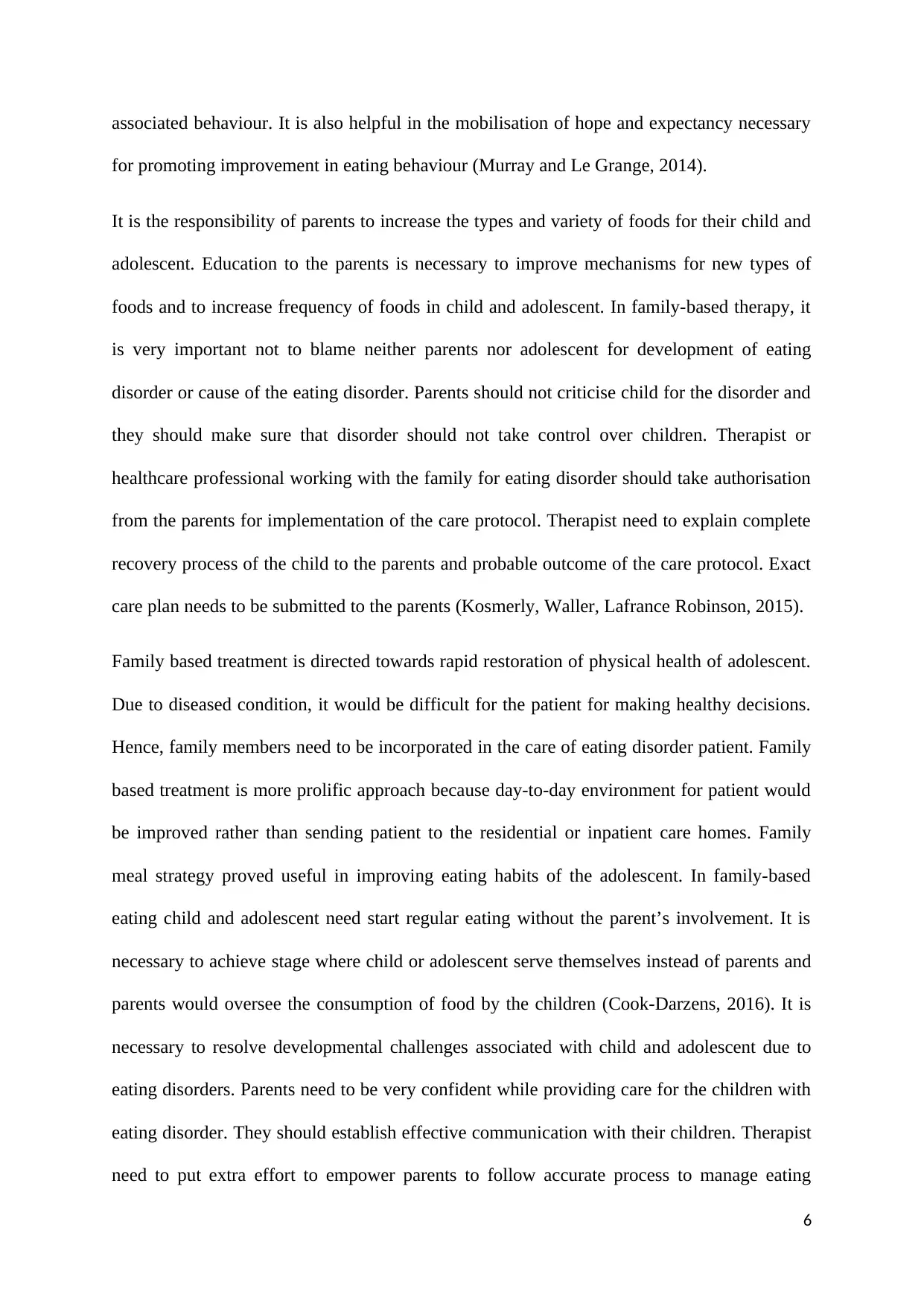
associated behaviour. It is also helpful in the mobilisation of hope and expectancy necessary
for promoting improvement in eating behaviour (Murray and Le Grange, 2014).
It is the responsibility of parents to increase the types and variety of foods for their child and
adolescent. Education to the parents is necessary to improve mechanisms for new types of
foods and to increase frequency of foods in child and adolescent. In family-based therapy, it
is very important not to blame neither parents nor adolescent for development of eating
disorder or cause of the eating disorder. Parents should not criticise child for the disorder and
they should make sure that disorder should not take control over children. Therapist or
healthcare professional working with the family for eating disorder should take authorisation
from the parents for implementation of the care protocol. Therapist need to explain complete
recovery process of the child to the parents and probable outcome of the care protocol. Exact
care plan needs to be submitted to the parents (Kosmerly, Waller, Lafrance Robinson, 2015).
Family based treatment is directed towards rapid restoration of physical health of adolescent.
Due to diseased condition, it would be difficult for the patient for making healthy decisions.
Hence, family members need to be incorporated in the care of eating disorder patient. Family
based treatment is more prolific approach because day-to-day environment for patient would
be improved rather than sending patient to the residential or inpatient care homes. Family
meal strategy proved useful in improving eating habits of the adolescent. In family-based
eating child and adolescent need start regular eating without the parent’s involvement. It is
necessary to achieve stage where child or adolescent serve themselves instead of parents and
parents would oversee the consumption of food by the children (Cook-Darzens, 2016). It is
necessary to resolve developmental challenges associated with child and adolescent due to
eating disorders. Parents need to be very confident while providing care for the children with
eating disorder. They should establish effective communication with their children. Therapist
need to put extra effort to empower parents to follow accurate process to manage eating
6
for promoting improvement in eating behaviour (Murray and Le Grange, 2014).
It is the responsibility of parents to increase the types and variety of foods for their child and
adolescent. Education to the parents is necessary to improve mechanisms for new types of
foods and to increase frequency of foods in child and adolescent. In family-based therapy, it
is very important not to blame neither parents nor adolescent for development of eating
disorder or cause of the eating disorder. Parents should not criticise child for the disorder and
they should make sure that disorder should not take control over children. Therapist or
healthcare professional working with the family for eating disorder should take authorisation
from the parents for implementation of the care protocol. Therapist need to explain complete
recovery process of the child to the parents and probable outcome of the care protocol. Exact
care plan needs to be submitted to the parents (Kosmerly, Waller, Lafrance Robinson, 2015).
Family based treatment is directed towards rapid restoration of physical health of adolescent.
Due to diseased condition, it would be difficult for the patient for making healthy decisions.
Hence, family members need to be incorporated in the care of eating disorder patient. Family
based treatment is more prolific approach because day-to-day environment for patient would
be improved rather than sending patient to the residential or inpatient care homes. Family
meal strategy proved useful in improving eating habits of the adolescent. In family-based
eating child and adolescent need start regular eating without the parent’s involvement. It is
necessary to achieve stage where child or adolescent serve themselves instead of parents and
parents would oversee the consumption of food by the children (Cook-Darzens, 2016). It is
necessary to resolve developmental challenges associated with child and adolescent due to
eating disorders. Parents need to be very confident while providing care for the children with
eating disorder. They should establish effective communication with their children. Therapist
need to put extra effort to empower parents to follow accurate process to manage eating
6

disorder in their children. Therapist need to remind the parents that they know how to feed
their children; however, due to eating disorder there might be doubt and disturbance in their
feeding to their children. It is necessary for the parents to be dependent on themselves for
selecting care plan rather than therapist because it would be helpful in augmenting their
confidence (Robinson, Dolhanty, Greenberg, 2015).
In family-based therapy for eating disorder, initial focus should be on symptoms reduction.
Major control on the eating disorder need to be achieved in the initial phase because long
term malnutrition would lead to physical and psychological disturbance in the patient. It
would be difficult to manage long-term damage of physical health of the patient. Eating
disorder is associated with psychological disorders like depressed mood, anxiety, irritability,
difficulty concentrating, or social withdrawal. However, in the initial phase of the treatment,
emphasis is not given for management of these psychological problems. In the initial phase of
the management of eating disorder, major emphasis is given to the weight restoration because
with the restoration of the weight other psychological problems can be effectively managed.
Even though, family-based therapy proved effective for both child and adolescent; few of the
families would not respond effectively for this treatment. In such scenario, multifamily
treatment of child and adolescent is the viable option. Conceptual focus of family-based
therapy and multifamily therapy is similar; however, effective families of family-based
therapy mobilise themselves to treat another child and adolescent. In multifamily therapy
usually 5 to 7 families take part and support each other based on their learning and experience
(Swenne, Parling, Salonen Ros, 2017).
Family-based treatment is usually provided in three phases like parental refeeding, adolescent
control of eating and weight processes and addressing of adolescent issues and termination.
Aim of parental feeding is promotion of taking charge of eating and weight-loss behaviours.
In this phase parents’ anxieties need to be modulated to encourage food consumption,
7
their children; however, due to eating disorder there might be doubt and disturbance in their
feeding to their children. It is necessary for the parents to be dependent on themselves for
selecting care plan rather than therapist because it would be helpful in augmenting their
confidence (Robinson, Dolhanty, Greenberg, 2015).
In family-based therapy for eating disorder, initial focus should be on symptoms reduction.
Major control on the eating disorder need to be achieved in the initial phase because long
term malnutrition would lead to physical and psychological disturbance in the patient. It
would be difficult to manage long-term damage of physical health of the patient. Eating
disorder is associated with psychological disorders like depressed mood, anxiety, irritability,
difficulty concentrating, or social withdrawal. However, in the initial phase of the treatment,
emphasis is not given for management of these psychological problems. In the initial phase of
the management of eating disorder, major emphasis is given to the weight restoration because
with the restoration of the weight other psychological problems can be effectively managed.
Even though, family-based therapy proved effective for both child and adolescent; few of the
families would not respond effectively for this treatment. In such scenario, multifamily
treatment of child and adolescent is the viable option. Conceptual focus of family-based
therapy and multifamily therapy is similar; however, effective families of family-based
therapy mobilise themselves to treat another child and adolescent. In multifamily therapy
usually 5 to 7 families take part and support each other based on their learning and experience
(Swenne, Parling, Salonen Ros, 2017).
Family-based treatment is usually provided in three phases like parental refeeding, adolescent
control of eating and weight processes and addressing of adolescent issues and termination.
Aim of parental feeding is promotion of taking charge of eating and weight-loss behaviours.
In this phase parents’ anxieties need to be modulated to encourage food consumption,
7
Paraphrase This Document
Need a fresh take? Get an instant paraphrase of this document with our AI Paraphraser
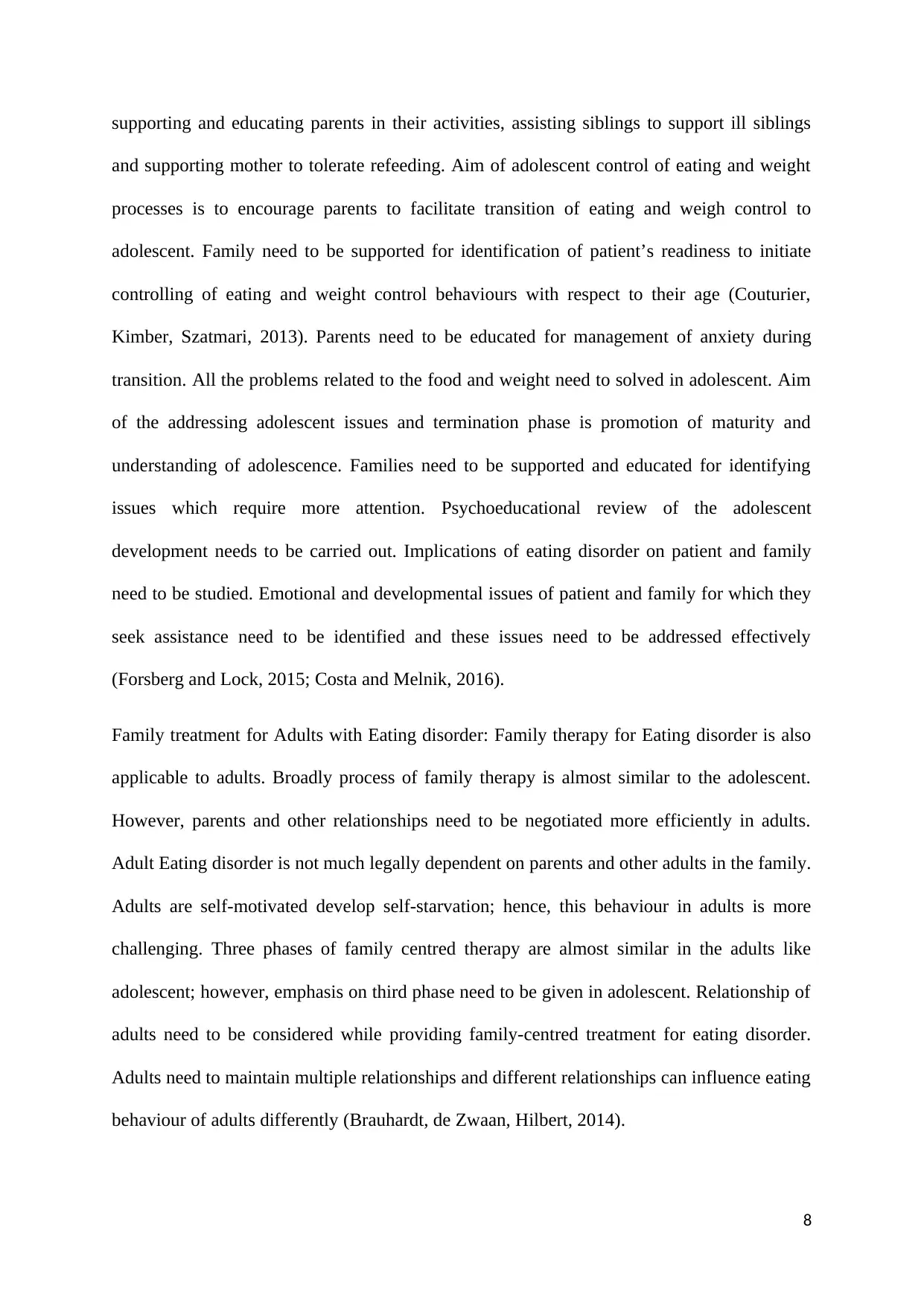
supporting and educating parents in their activities, assisting siblings to support ill siblings
and supporting mother to tolerate refeeding. Aim of adolescent control of eating and weight
processes is to encourage parents to facilitate transition of eating and weigh control to
adolescent. Family need to be supported for identification of patient’s readiness to initiate
controlling of eating and weight control behaviours with respect to their age (Couturier,
Kimber, Szatmari, 2013). Parents need to be educated for management of anxiety during
transition. All the problems related to the food and weight need to solved in adolescent. Aim
of the addressing adolescent issues and termination phase is promotion of maturity and
understanding of adolescence. Families need to be supported and educated for identifying
issues which require more attention. Psychoeducational review of the adolescent
development needs to be carried out. Implications of eating disorder on patient and family
need to be studied. Emotional and developmental issues of patient and family for which they
seek assistance need to be identified and these issues need to be addressed effectively
(Forsberg and Lock, 2015; Costa and Melnik, 2016).
Family treatment for Adults with Eating disorder: Family therapy for Eating disorder is also
applicable to adults. Broadly process of family therapy is almost similar to the adolescent.
However, parents and other relationships need to be negotiated more efficiently in adults.
Adult Eating disorder is not much legally dependent on parents and other adults in the family.
Adults are self-motivated develop self-starvation; hence, this behaviour in adults is more
challenging. Three phases of family centred therapy are almost similar in the adults like
adolescent; however, emphasis on third phase need to be given in adolescent. Relationship of
adults need to be considered while providing family-centred treatment for eating disorder.
Adults need to maintain multiple relationships and different relationships can influence eating
behaviour of adults differently (Brauhardt, de Zwaan, Hilbert, 2014).
8
and supporting mother to tolerate refeeding. Aim of adolescent control of eating and weight
processes is to encourage parents to facilitate transition of eating and weigh control to
adolescent. Family need to be supported for identification of patient’s readiness to initiate
controlling of eating and weight control behaviours with respect to their age (Couturier,
Kimber, Szatmari, 2013). Parents need to be educated for management of anxiety during
transition. All the problems related to the food and weight need to solved in adolescent. Aim
of the addressing adolescent issues and termination phase is promotion of maturity and
understanding of adolescence. Families need to be supported and educated for identifying
issues which require more attention. Psychoeducational review of the adolescent
development needs to be carried out. Implications of eating disorder on patient and family
need to be studied. Emotional and developmental issues of patient and family for which they
seek assistance need to be identified and these issues need to be addressed effectively
(Forsberg and Lock, 2015; Costa and Melnik, 2016).
Family treatment for Adults with Eating disorder: Family therapy for Eating disorder is also
applicable to adults. Broadly process of family therapy is almost similar to the adolescent.
However, parents and other relationships need to be negotiated more efficiently in adults.
Adult Eating disorder is not much legally dependent on parents and other adults in the family.
Adults are self-motivated develop self-starvation; hence, this behaviour in adults is more
challenging. Three phases of family centred therapy are almost similar in the adults like
adolescent; however, emphasis on third phase need to be given in adolescent. Relationship of
adults need to be considered while providing family-centred treatment for eating disorder.
Adults need to maintain multiple relationships and different relationships can influence eating
behaviour of adults differently (Brauhardt, de Zwaan, Hilbert, 2014).
8

It is evident that outcome of family therapy is more in comparison to the standard care and no
treatment. However, individualised therapy in adolescents proved more effective in
comparison to the family centred therapy. It is evident that most of the adults prefer
individualised therapy rather than family-based therapy. Adolescents are more resistant to
family-based therapy. It is necessary to establish higher therapeutic relationship between the
patient and other family members in family-based therapy. However, no valid data is
available to prove superiority of family centred therapy or individualised therapy. Moreover,
there is no substantial data available for establishing combined effect of family centred
therapy and individualised therapy. It is necessary to establish extent to which and
circumstances in which family centred therapy is applicable because eating disorder in a
multifactorial disease and different factors affect eating behaviour differently. It is necessary
to identify age and other behavioural aspects of the patients, to whom eating disorder
intervention is required. Effective evaluation programme needs to implemented for eating
disorder (Sadeh-Sharvit, Zubery, Mankovski, Steiner, Lock, 2016).
Conclusion:
Eating disorders are the psychological disorders which affect quality of life and associated
with significant morbidity and mortality. In the management of the eating disorder, family
members like parents and siblings need to be at the central. Therapist need to work in
coordination with the parents to improve effectiveness of family-based therapy. Family based
intervention proved to be effective for the management of eating disorders. Multifamily
therapy is the additional support for the family-based therapy for providing effective
intervention to child and adolescent. Development, implementation and its proven usefulness
in the eating disorders made family-based therapy as first line therapy for eating disorders. It
improved the recovery process in the children and adolescent, and proved significant
landscape in the treatment and management of eating disorders. However, further research is
9
treatment. However, individualised therapy in adolescents proved more effective in
comparison to the family centred therapy. It is evident that most of the adults prefer
individualised therapy rather than family-based therapy. Adolescents are more resistant to
family-based therapy. It is necessary to establish higher therapeutic relationship between the
patient and other family members in family-based therapy. However, no valid data is
available to prove superiority of family centred therapy or individualised therapy. Moreover,
there is no substantial data available for establishing combined effect of family centred
therapy and individualised therapy. It is necessary to establish extent to which and
circumstances in which family centred therapy is applicable because eating disorder in a
multifactorial disease and different factors affect eating behaviour differently. It is necessary
to identify age and other behavioural aspects of the patients, to whom eating disorder
intervention is required. Effective evaluation programme needs to implemented for eating
disorder (Sadeh-Sharvit, Zubery, Mankovski, Steiner, Lock, 2016).
Conclusion:
Eating disorders are the psychological disorders which affect quality of life and associated
with significant morbidity and mortality. In the management of the eating disorder, family
members like parents and siblings need to be at the central. Therapist need to work in
coordination with the parents to improve effectiveness of family-based therapy. Family based
intervention proved to be effective for the management of eating disorders. Multifamily
therapy is the additional support for the family-based therapy for providing effective
intervention to child and adolescent. Development, implementation and its proven usefulness
in the eating disorders made family-based therapy as first line therapy for eating disorders. It
improved the recovery process in the children and adolescent, and proved significant
landscape in the treatment and management of eating disorders. However, further research is
9

necessary to identify reasons for ineffective family-based therapy for specific families.
Further improvements and adaptations are necessary in the family-based therapy to improve
its effectiveness in the non-respondents. Also, ways need to be identified to improve
adherence of children and parents to family-based therapy for eating disorders.
10
Further improvements and adaptations are necessary in the family-based therapy to improve
its effectiveness in the non-respondents. Also, ways need to be identified to improve
adherence of children and parents to family-based therapy for eating disorders.
10
Secure Best Marks with AI Grader
Need help grading? Try our AI Grader for instant feedback on your assignments.
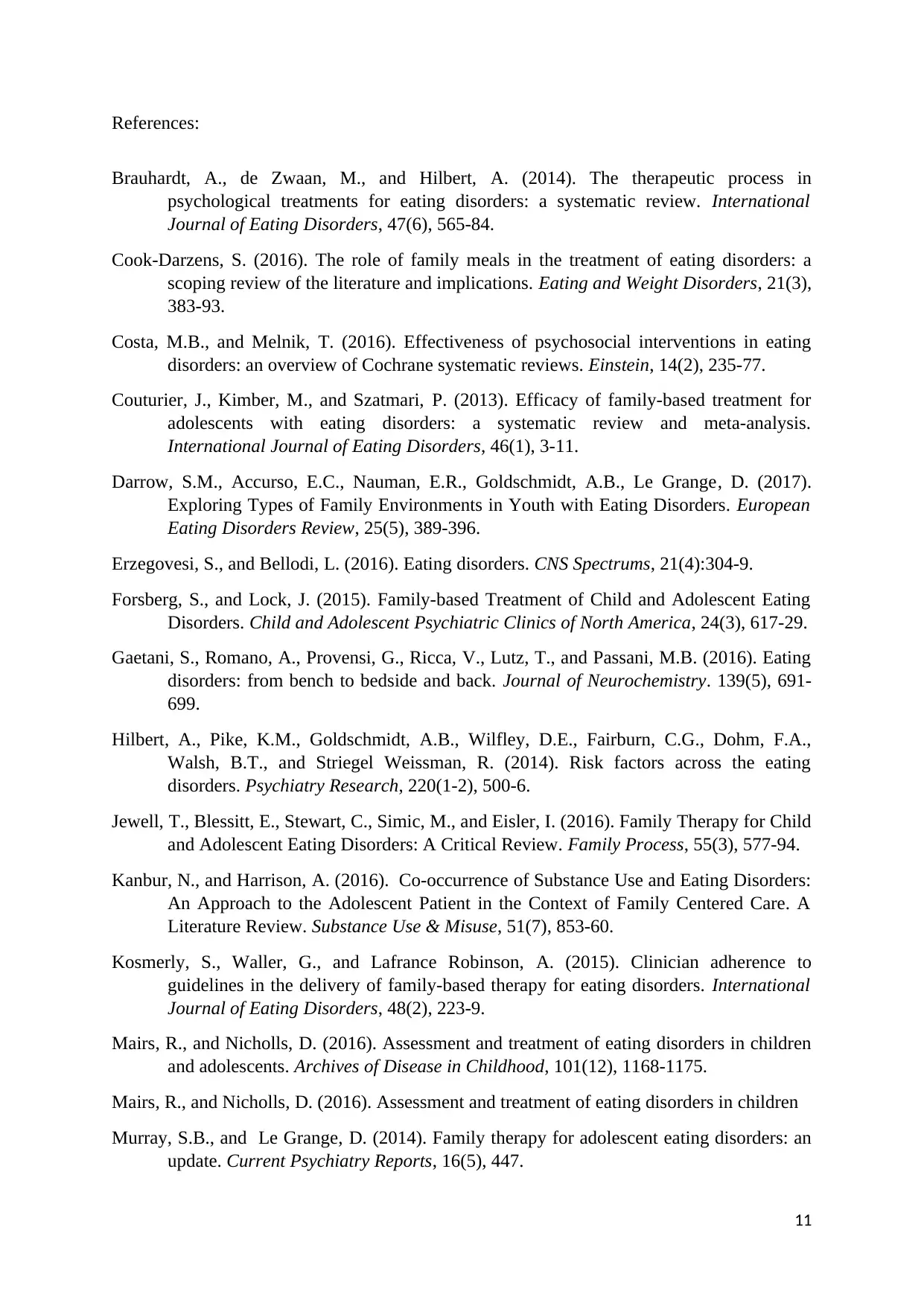
References:
Brauhardt, A., de Zwaan, M., and Hilbert, A. (2014). The therapeutic process in
psychological treatments for eating disorders: a systematic review. International
Journal of Eating Disorders, 47(6), 565-84.
Cook-Darzens, S. (2016). The role of family meals in the treatment of eating disorders: a
scoping review of the literature and implications. Eating and Weight Disorders, 21(3),
383-93.
Costa, M.B., and Melnik, T. (2016). Effectiveness of psychosocial interventions in eating
disorders: an overview of Cochrane systematic reviews. Einstein, 14(2), 235-77.
Couturier, J., Kimber, M., and Szatmari, P. (2013). Efficacy of family-based treatment for
adolescents with eating disorders: a systematic review and meta-analysis.
International Journal of Eating Disorders, 46(1), 3-11.
Darrow, S.M., Accurso, E.C., Nauman, E.R., Goldschmidt, A.B., Le Grange, D. (2017).
Exploring Types of Family Environments in Youth with Eating Disorders. European
Eating Disorders Review, 25(5), 389-396.
Erzegovesi, S., and Bellodi, L. (2016). Eating disorders. CNS Spectrums, 21(4):304-9.
Forsberg, S., and Lock, J. (2015). Family-based Treatment of Child and Adolescent Eating
Disorders. Child and Adolescent Psychiatric Clinics of North America, 24(3), 617-29.
Gaetani, S., Romano, A., Provensi, G., Ricca, V., Lutz, T., and Passani, M.B. (2016). Eating
disorders: from bench to bedside and back. Journal of Neurochemistry. 139(5), 691-
699.
Hilbert, A., Pike, K.M., Goldschmidt, A.B., Wilfley, D.E., Fairburn, C.G., Dohm, F.A.,
Walsh, B.T., and Striegel Weissman, R. (2014). Risk factors across the eating
disorders. Psychiatry Research, 220(1-2), 500-6.
Jewell, T., Blessitt, E., Stewart, C., Simic, M., and Eisler, I. (2016). Family Therapy for Child
and Adolescent Eating Disorders: A Critical Review. Family Process, 55(3), 577-94.
Kanbur, N., and Harrison, A. (2016). Co-occurrence of Substance Use and Eating Disorders:
An Approach to the Adolescent Patient in the Context of Family Centered Care. A
Literature Review. Substance Use & Misuse, 51(7), 853-60.
Kosmerly, S., Waller, G., and Lafrance Robinson, A. (2015). Clinician adherence to
guidelines in the delivery of family-based therapy for eating disorders. International
Journal of Eating Disorders, 48(2), 223-9.
Mairs, R., and Nicholls, D. (2016). Assessment and treatment of eating disorders in children
and adolescents. Archives of Disease in Childhood, 101(12), 1168-1175.
Mairs, R., and Nicholls, D. (2016). Assessment and treatment of eating disorders in children
Murray, S.B., and Le Grange, D. (2014). Family therapy for adolescent eating disorders: an
update. Current Psychiatry Reports, 16(5), 447.
11
Brauhardt, A., de Zwaan, M., and Hilbert, A. (2014). The therapeutic process in
psychological treatments for eating disorders: a systematic review. International
Journal of Eating Disorders, 47(6), 565-84.
Cook-Darzens, S. (2016). The role of family meals in the treatment of eating disorders: a
scoping review of the literature and implications. Eating and Weight Disorders, 21(3),
383-93.
Costa, M.B., and Melnik, T. (2016). Effectiveness of psychosocial interventions in eating
disorders: an overview of Cochrane systematic reviews. Einstein, 14(2), 235-77.
Couturier, J., Kimber, M., and Szatmari, P. (2013). Efficacy of family-based treatment for
adolescents with eating disorders: a systematic review and meta-analysis.
International Journal of Eating Disorders, 46(1), 3-11.
Darrow, S.M., Accurso, E.C., Nauman, E.R., Goldschmidt, A.B., Le Grange, D. (2017).
Exploring Types of Family Environments in Youth with Eating Disorders. European
Eating Disorders Review, 25(5), 389-396.
Erzegovesi, S., and Bellodi, L. (2016). Eating disorders. CNS Spectrums, 21(4):304-9.
Forsberg, S., and Lock, J. (2015). Family-based Treatment of Child and Adolescent Eating
Disorders. Child and Adolescent Psychiatric Clinics of North America, 24(3), 617-29.
Gaetani, S., Romano, A., Provensi, G., Ricca, V., Lutz, T., and Passani, M.B. (2016). Eating
disorders: from bench to bedside and back. Journal of Neurochemistry. 139(5), 691-
699.
Hilbert, A., Pike, K.M., Goldschmidt, A.B., Wilfley, D.E., Fairburn, C.G., Dohm, F.A.,
Walsh, B.T., and Striegel Weissman, R. (2014). Risk factors across the eating
disorders. Psychiatry Research, 220(1-2), 500-6.
Jewell, T., Blessitt, E., Stewart, C., Simic, M., and Eisler, I. (2016). Family Therapy for Child
and Adolescent Eating Disorders: A Critical Review. Family Process, 55(3), 577-94.
Kanbur, N., and Harrison, A. (2016). Co-occurrence of Substance Use and Eating Disorders:
An Approach to the Adolescent Patient in the Context of Family Centered Care. A
Literature Review. Substance Use & Misuse, 51(7), 853-60.
Kosmerly, S., Waller, G., and Lafrance Robinson, A. (2015). Clinician adherence to
guidelines in the delivery of family-based therapy for eating disorders. International
Journal of Eating Disorders, 48(2), 223-9.
Mairs, R., and Nicholls, D. (2016). Assessment and treatment of eating disorders in children
and adolescents. Archives of Disease in Childhood, 101(12), 1168-1175.
Mairs, R., and Nicholls, D. (2016). Assessment and treatment of eating disorders in children
Murray, S.B., and Le Grange, D. (2014). Family therapy for adolescent eating disorders: an
update. Current Psychiatry Reports, 16(5), 447.
11
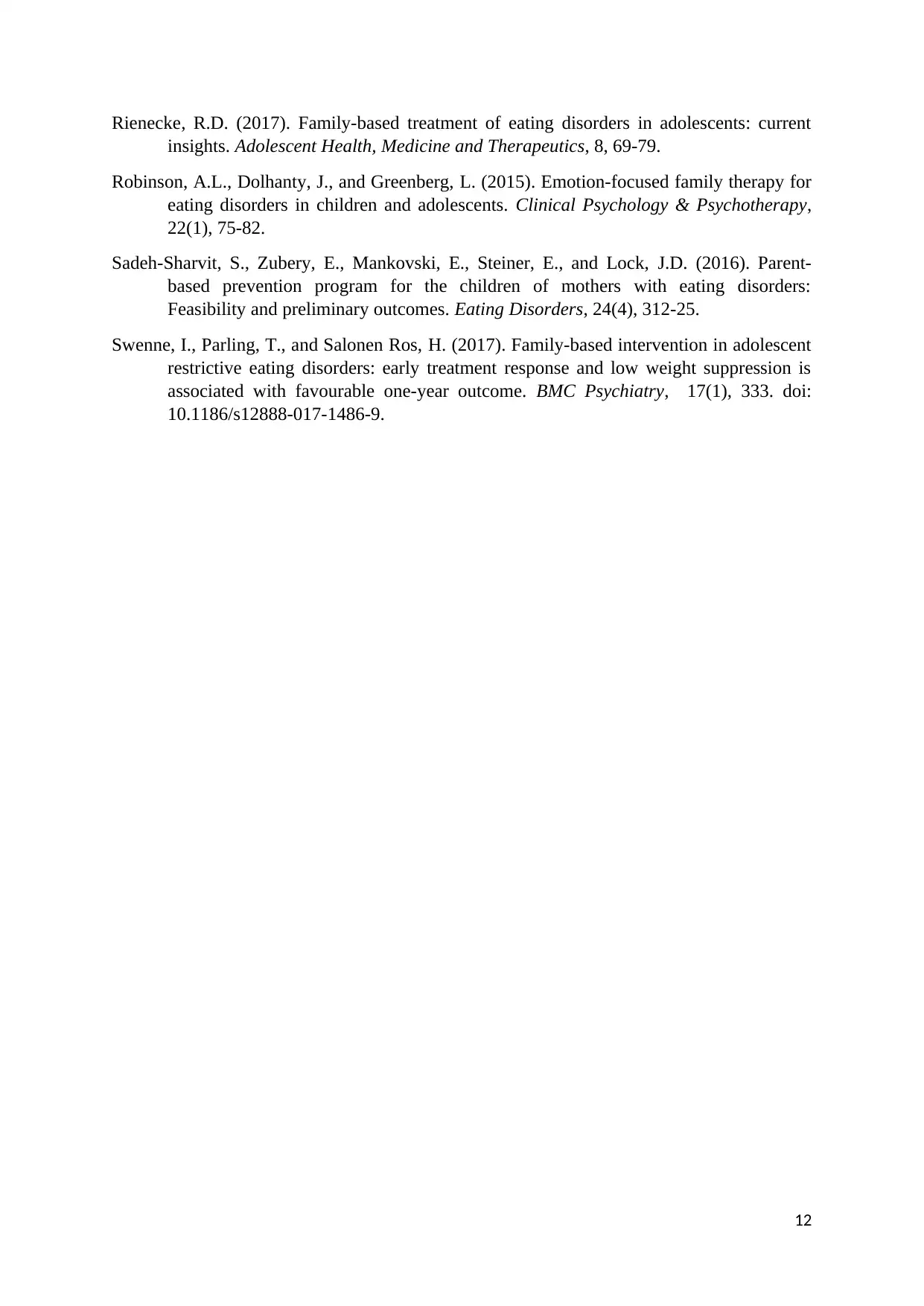
Rienecke, R.D. (2017). Family-based treatment of eating disorders in adolescents: current
insights. Adolescent Health, Medicine and Therapeutics, 8, 69-79.
Robinson, A.L., Dolhanty, J., and Greenberg, L. (2015). Emotion-focused family therapy for
eating disorders in children and adolescents. Clinical Psychology & Psychotherapy,
22(1), 75-82.
Sadeh-Sharvit, S., Zubery, E., Mankovski, E., Steiner, E., and Lock, J.D. (2016). Parent-
based prevention program for the children of mothers with eating disorders:
Feasibility and preliminary outcomes. Eating Disorders, 24(4), 312-25.
Swenne, I., Parling, T., and Salonen Ros, H. (2017). Family-based intervention in adolescent
restrictive eating disorders: early treatment response and low weight suppression is
associated with favourable one-year outcome. BMC Psychiatry, 17(1), 333. doi:
10.1186/s12888-017-1486-9.
12
insights. Adolescent Health, Medicine and Therapeutics, 8, 69-79.
Robinson, A.L., Dolhanty, J., and Greenberg, L. (2015). Emotion-focused family therapy for
eating disorders in children and adolescents. Clinical Psychology & Psychotherapy,
22(1), 75-82.
Sadeh-Sharvit, S., Zubery, E., Mankovski, E., Steiner, E., and Lock, J.D. (2016). Parent-
based prevention program for the children of mothers with eating disorders:
Feasibility and preliminary outcomes. Eating Disorders, 24(4), 312-25.
Swenne, I., Parling, T., and Salonen Ros, H. (2017). Family-based intervention in adolescent
restrictive eating disorders: early treatment response and low weight suppression is
associated with favourable one-year outcome. BMC Psychiatry, 17(1), 333. doi:
10.1186/s12888-017-1486-9.
12
1 out of 12
Related Documents
Your All-in-One AI-Powered Toolkit for Academic Success.
+13062052269
info@desklib.com
Available 24*7 on WhatsApp / Email
![[object Object]](/_next/static/media/star-bottom.7253800d.svg)
Unlock your academic potential
© 2024 | Zucol Services PVT LTD | All rights reserved.





